# 二、在 Eager 模式中使用指标
大家好! 在本教程中,我们将学习如何使用各种指标来评估在 TensorFlow 中使用 Eager 模式时神经网络的表现。
我玩了很久 TensorFlow Eager 模式,我喜欢它。对我来说,与使用声明模式相比,API 看起来非常直观,现在一切看起来都更容易构建。 我现在发现的主要不便之处(我使用的是 1.7 版)是使用 Eager 模式时,`tf.metrics`还不兼容。 尽管如此,我已经构建了几个函数,可以帮助你评估网络的表现,同时仍然享受凭空构建网络的强大之处。
教程步骤:
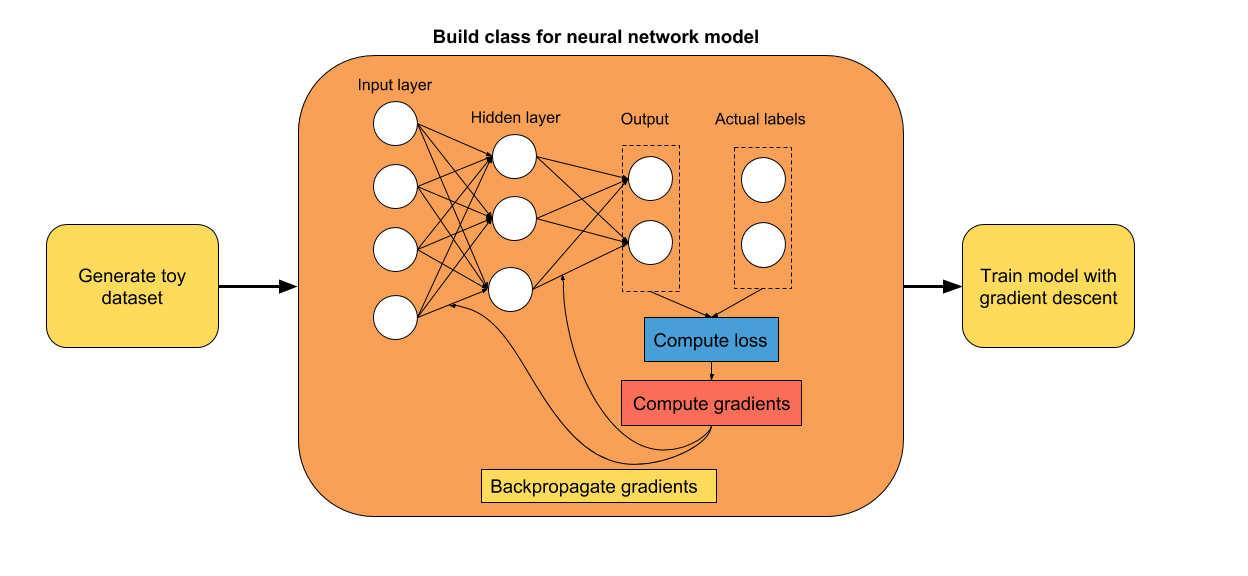
我选择了三个案例:
多分类
对于此任务,我们将使用准确率,混淆矩阵和平均精度以及召回率,来评估我们模型的表现。
不平衡的二分类
当我们处理不平衡的数据集时,模型的准确率不是可靠的度量。 因此,我们将使用 ROC-AUC 分数,这似乎是一个更适合不平衡问题的指标。
回归
为了评估我们的回归模型的性能,我们将使用 R ^ 2 分数(确定系数)。
我相信这些案例的多样性足以帮助你进一步学习任何机器学习项目。 如果你希望我添加下面未遇到的任何额外指标,请告知我们,我会尽力在以后添加它们。 那么,让我们开始吧!
TensorFlow 版本 - 1.7
## 导入重要的库并开启 Eager 模式
```py
# 导入 TensorFlow 和 TensorFlow Eager
import tensorflow as tf
import tensorflow.contrib.eager as tfe
# 导入函数来生成玩具分类问题
from sklearn.datasets import load_wine
from sklearn.datasets import make_classification
from sklearn.datasets import make_regression
# 为数据预处理导入 numpy
import numpy as np
# 导入绘图库
import matplotlib.pyplot as plt
%matplotlib inline
# 为降维导入 PCA
from sklearn.decomposition import PCA
# 开启 Eager 模式。一旦开启不能撤销!只执行一次。
tfe.enable_eager_execution()
```
## 第一部分:用于多分类的的数据集
```py
wine_data = load_wine()
print('Type of data in the wine_data dictionary: ', list(wine_data.keys()))
'''
Type of data in the wine_data dictionary: ['data', 'target', 'target_names', 'DESCR', 'feature_names']
'''
print('Number of classes: ', len(np.unique(wine_data.target)))
# Number of classes: 3
print('Distribution of our targets: ', np.unique(wine_data.target, return_counts=True)[1])
# Distribution of our targets: [59 71 48]
print('Number of features in the dataset: ', wine_data.data.shape[1])
# Number of features in the dataset: 13
```
### 特征标准化
每个特征的比例变化很大,如下面的单元格所示。 为了加快训练速度,我们将每个特征标准化为零均值和单位标准差。 这个过程称为标准化,它对神经网络的收敛非常有帮助。
```py
# 数据集标准化
wine_data.data = (wine_data.data - np.mean(wine_data.data, axis=0))/np.std(wine_data.data, axis=0)
print('Standard deviation of each feature after standardization: ', np.std(wine_data.data, axis=0))
# Standard deviation of each feature after standardization: [1. 1. 1. 1. 1. 1. 1. 1. 1. 1. 1. 1. 1.]
```
### 数据可视化:使用 PCA 降到二维
我们将使用 PCA,仅用于可视化目的。 我们将使用所有 13 个特征来训练我们的神经网络。
让我们看看这三个类如何在 2D 空间中表示。
```py
X_pca = PCA(n_components=2, random_state=2018).fit_transform(wine_data.data)
plt.scatter(X_pca[:,0], X_pca[:,1], c=wine_data.target, cmap=plt.cm.spring)
plt.xlabel('First PCA component', fontsize=15)
plt.ylabel('Second PCA component', fontsize=15)
plt.title('Multi-classification problem', fontsize=15)
plt.show()
```
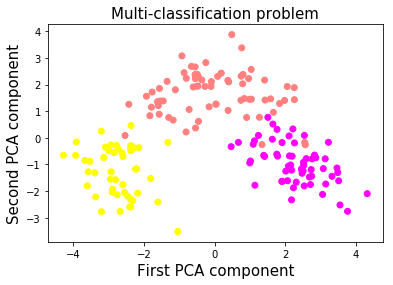
好的,所以这些类看起来很容易分开。 顺便说一句,我实际上在特征标准化之前尝试使用 PCA,粉色和黄色类重叠。 通过在降维之前标准化特征,我们设法在它们之间获得了清晰的界限。
### 让我们使用 TensorFlow Eager API 构建双层神经网络
你可能已经注意到,使用 TensorFlow Eager 构建模型的最方便方法是使用类。 我认为,为模型使用类可以更容易地组织和添加新组件。 你只需定义初始化期间要使用的层,然后在预测期间使用它们。 它使得在预测阶段更容易阅读模型的架构。
```py
class two_layer_nn(tf.keras.Model):
def __init__(self, output_size=2, loss_type='cross-entropy'):
super(two_layer_nn, self).__init__()
""" 在这里定义正向传播期间
使用的神经网络层
Args:
output_size: int (default=2).
loss_type: string, 'cross-entropy' or 'regression' (default='cross-entropy')
"""
# 第一个隐层
self.dense_1 = tf.layers.Dense(20, activation=tf.nn.relu)
# 第二个隐层
self.dense_2 = tf.layers.Dense(10, activation=tf.nn.relu)
# 输出层,未缩放的对数概率
self.dense_out = tf.layers.Dense(output_size, activation=None)
# 初始化损失类型
self.loss_type = loss_type
def predict(self, input_data):
""" 在神经网络上执行正向传播
Args:
input_data: 2D tensor of shape (n_samples, n_features).
Returns:
logits: unnormalized predictions.
"""
layer_1 = self.dense_1(input_data)
layer_2 = self.dense_2(layer_1)
logits = self.dense_out(layer_2)
return logits
def loss_fn(self, input_data, target):
""" 定义训练期间使用的损失函数
"""
preds = self.predict(input_data)
if self.loss_type=='cross-entropy':
loss = tf.losses.sparse_softmax_cross_entropy(labels=target, logits=preds)
else:
loss = tf.losses.mean_squared_error(target, preds)
return loss
def grads_fn(self, input_data, target):
""" 在每个正向步骤中,
动态计算损失值对模型参数的梯度
"""
with tfe.GradientTape() as tape:
loss = self.loss_fn(input_data, target)
return tape.gradient(loss, self.variables)
def fit(self, input_data, target, optimizer, num_epochs=500,
verbose=50, track_accuracy=True):
""" 用于训练模型的函数,
使用所选的优化器,执行所需数量的迭代
"""
if track_accuracy:
# Initialize list to store the accuracy of the model
self.hist_accuracy = []
# Initialize class to compute the accuracy metric
accuracy = tfe.metrics.Accuracy()
for i in range(num_epochs):
# Take a step of gradient descent
grads = self.grads_fn(input_data, target)
optimizer.apply_gradients(zip(grads, self.variables))
if track_accuracy:
# Predict targets after taking a step of gradient descent
logits = self.predict(X)
preds = tf.argmax(logits, axis=1)
# Compute the accuracy
accuracy(preds, target)
# Get the actual result and add it to our list
self.hist_accuracy.append(accuracy.result())
# Reset accuracy value (we don't want to track the running mean accuracy)
accuracy.init_variables()
```
### 准确率指标
为了使用准确率指标评估模型的表现,我们将使用`tfe.metrics.Accuracy`类。 在批量训练模型时,此指标非常有用,因为它会在每次调用时计算批量的平均精度。 当我们在每个步骤中使用整个数据集训练模型时,我们将重置此指标,因为我们不希望它跟踪运行中的平均值。
```py
# 创建输入特征和标签。将数据从 numpy 转换为张量
X = tf.constant(wine_data.data)
y = tf.constant(wine_data.target)
# 定义优化器
optimizer = tf.train.GradientDescentOptimizer(5e-1)
# 初始化模型
model = two_layer_nn(output_size=3)
# 在这里选择迭代数量
num_epochs = 5
# 使用梯度下降训练模型
model.fit(X, y, optimizer, num_epochs=num_epochs)
plt.plot(range(num_epochs), model.hist_accuracy);
plt.xlabel('Epoch number', fontsize=15);
plt.ylabel('Accuracy', fontsize=15);
plt.title('Training accuracy history', fontsize=15);
```
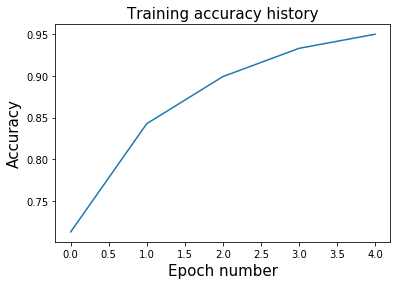
### 混淆矩阵
在训练完算法后展示混淆矩阵是一种很好的方式,可以全面了解网络表现。 TensorFlow 具有内置函数来计算混淆矩阵,幸运的是它与 Eager 模式兼容。 因此,让我们可视化此数据集的混淆矩阵。
```py
# 获得整个数据集上的预测
logits = model.predict(X)
preds = tf.argmax(logits, axis=1)
# 打印混淆矩阵
conf_matrix = tf.confusion_matrix(y, preds, num_classes=3)
print('Confusion matrix: \n', conf_matrix.numpy())
'''
Confusion matrix:
[[56 3 0]
[ 2 66 3]
[ 0 1 47]]
'''
```
对角矩阵显示真正例,而矩阵的其它地方显示假正例。
### 精准率得分
上面计算的混淆矩阵使得计算平均精确率非常容易。 我将在下面实现一个函数,它会自动为你计算。 你还可以指定每个类的权重。 例如,由于某些原因,第二类的精确率可能对你来说更重要。
```py
def precision(labels, predictions, weights=None):
conf_matrix = tf.confusion_matrix(labels, predictions, num_classes=3)
tp_and_fp = tf.reduce_sum(conf_matrix, axis=0)
tp = tf.diag_part(conf_matrix)
precision_scores = tp/(tp_and_fp)
if weights:
precision_score = tf.multiply(precision_scores, weights)/tf.reduce_sum(weights)
else:
precision_score = tf.reduce_mean(precision_scores)
return precision_score
precision_score = precision(y, preds, weights=None)
print('Average precision: ', precision_score.numpy())
# Average precision: 0.9494581280788177
```
### 召回率得分
平均召回率的计算与精确率非常相似。 我们不是对列进行求和,而是对行进行求和,来获得真正例和假负例的总数。
```py
def recall(labels, predictions, weights=None):
conf_matrix = tf.confusion_matrix(labels, predictions, num_classes=3)
tp_and_fn = tf.reduce_sum(conf_matrix, axis=1)
tp = tf.diag_part(conf_matrix)
recall_scores = tp/(tp_and_fn)
if weights:
recall_score = tf.multiply(recall_scores, weights)/tf.reduce_sum(weights)
else:
recall_score = tf.reduce_mean(recall_scores)
return recall_score
recall_score = recall(y, preds, weights=None)
print('Average precision: ', recall_score.numpy())
# Average precision: 0.9526322246094269
```
## 第二部分:不平衡二分类
当你开始使用真实数据集时,你会很快发现大多数问题都是不平衡的。 例如,考虑到异常样本与正常样本的比例,异常检测问题严重不平衡。 在这些情况下,评估网络性能的更合适的指标是 ROC-AUC 得分。 那么,让我们构建我们的不平衡数据集并开始研究它!
```py
XX,, yy == make_classificationmake_cla (n_samples=1000, n_features=2, n_informative=2,
n_redundant=0, n_classes=2, n_clusters_per_class=1,
flip_y=0.1, class_sep=4, hypercube=False,
shift=0.0, scale=1.0, random_state=2018)
# 减少标签为 1 的样本数
X = np.vstack([X[y==0], X[y==1][:50]])
y = np.hstack([y[y==0], y[y==1][:50]])
```
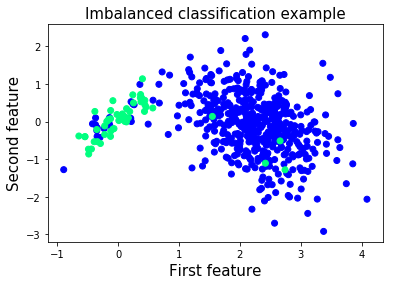
我们将使用相同的神经网络架构。 我们只需用`num_classes = 2`初始化模型,因为我们正在处理二分类问题。
```py
# Numpy 数组变为张量
X = tf.constant(X)
y = tf.constant(y)
```
让我们将模型只训练几个迭代,来避免过拟合。
```py
# 定义优化器
optimizer = tf.train.GradientDescentOptimizer(5e-1)
# 初始化模型
model = two_layer_nn(output_size=2)
# 在这里选择迭代数量
num_epochs = 5
# 使用梯度下降训练模型
model.fit(X, y, optimizer, num_epochs=num_epochs)
```
### 如何计算 ROC-AUC 得分
为了计算 ROC-AUC 得分,我们将使用`tf.metric.auc`的相同方法。 对于每个概率阈值,我们将计算真正例,真负例,假正例和假负例的数量。 在计算这些统计数据后,我们可以计算每个概率阈值的真正例率和真负例率。
为了近似 ROC 曲线下的面积,我们将使用黎曼和和梯形规则。 如果你想了解更多信息,请点击[此处](https://www.khanacademy.org/math/ap-calculus-ab/ab-accumulation-riemann-sums/ab-midpoint-trapezoid/a/understanding-the-trapezoid-rule)。
### ROC-AUC 函数
```py
def roc_auc(labels, predictions, thresholds, get_fpr_tpr=True):
tpr = []
fpr = []
for th in thresholds:
# 计算真正例数量
tp_cases = tf.where((tf.greater_equal(predictions, th)) &
(tf.equal(labels, 1)))
tp = tf.size(tp_cases)
# 计算真负例数量
tn_cases = tf.where((tf.less(predictions, th)) &
(tf.equal(labels, 0)))
tn = tf.size(tn_cases)
# 计算假正例数量
fp_cases = tf.where((tf.greater_equal(predictions, th)) &
(tf.equal(labels,0)))
fp = tf.size(fp_cases)
# 计算假负例数量
fn_cases = tf.where((tf.less(predictions, th)) &
(tf.equal(labels,1)))
fn = tf.size(fn_cases)
# 计算该阈值的真正例率
tpr_th = tp/(tp + fn)
# 计算该阈值的假正例率
fpr_th = fp/(fp + tn)
# 附加到整个真正例率列表
tpr.append(tpr_th)
# 附加到整个假正例率列表
fpr.append(fpr_th)
# 使用黎曼和和梯形法则,计算曲线下的近似面积
auc_score = 0
for i in range(0, len(thresholds)-1):
height_step = tf.abs(fpr[i+1]-fpr[i])
b1 = tpr[i]
b2 = tpr[i+1]
step_area = height_step*(b1+b2)/2
auc_score += step_area
return auc_score, fpr, tpr
```
### 为我们训练的模型计算 ROC-AUC 得分并绘制 ROC 曲线
```py
# 阈值更多意味着曲线下的近似面积的粒度更高
# 随意尝试阈值的数量
num_thresholds = 1000
thresholds = tf.lin_space(0.0, 1.0, num_thresholds).numpy()
# 将Softmax应用于我们的预测,因为模型的输出是非标准化的
# 选择我们的正类的预测(样本较少的类)
preds = tf.nn.softmax(model.predict(X))[:,1]
# 计算 ROC-AUC 得分并获得每个阈值的 TPR 和 FPR
auc_score, fpr_list, tpr_list = roc_auc(y, preds, thresholds)
print('ROC-AUC score of the model: ', auc_score.numpy())
# ROC-AUC score of the model: 0.93493986
plt.plot(fpr_list, tpr_list, label='AUC score: %.2f' %auc_score);
plt.xlabel('False Positive Rate', fontsize=15);
plt.ylabel('True Positive Rate', fontsize=15);
plt.title('ROC curve');
plt.legend(fontsize=15);
```

## 第三部分:用于回归的数据集
我们最终的数据集为简单的回归任务而创建。 在前两个问题中,网络的输出表示样本所属的类。这里网络的输出是连续的,是一个实数。
我们的输入数据集仅包含一个特征,以便使绘图保持简单。 标签`y`是实数向量。
让我们创建我们的玩具数据集!
```py
X, y = make_regression(n_samples=100, n_features=1, n_informative=1, noise=30,
random_state=2018)
```
### 展示输入特征和标签
为了更好地了解我们正在处理的问题,让我们绘制标签和输入特征。
```py
pltplt..scatterscatter((XX,, yy););
pltplt..xlabelxlabel(('Input''Input',, fontsizefontsize=15);
plt.ylabel('Target', fontsize=15);
plt.title('Toy regression problem', fontsize=15);
```
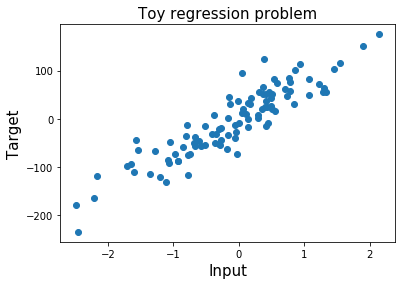
```py
# Numpy 数组转为张量
X = tf.constant(X)
y = tf.constant(y)
y = tf.reshape(y, [-1,1]) # 从行向量变为列向量
```
### 用于回归任务的神经网络
我们可以重复使用上面创建的双层神经网络。 由于我们只需要预测一个实数,因此网络的输出大小为 1。
我们必须重新定义我们的损失函数,因为我们无法继续使用`softmax`交叉熵损失。 相反,我们将使用均方误差损失函数。 我们还将定义一个新的优化器,其学习速率比前一个更小。
随意调整迭代的数量。
```py
# 定义优化器
optimizer = tf.train.GradientDescentOptimizer(1e-4)
# 初始化模型
model = two_layer_nn(output_size=1, loss_type='regression')
# 选择迭代数量
num_epochs = 300
# 使用梯度下降训练模型
model.fit(X, y, optimizer, num_epochs=num_epochs,
track_accuracy=False)
```
### 计算 R^2 得分(决定系数)
如果你曾经处理过回归问题,那么你可能已经听说过这个得分。
这个指标计算输入特征与目标之间的变异百分率,由我们的模型解释。R^2 得分的值范围介于 0 和 1 之间。R^2 得分为 1 意味着该模型可以进行完美的预测。 始终预测目标`y`的平均值,R^2 得分为 0。
R^2 可能为的负值。 在这种情况下,这意味着比起总是预测目标变量的平均值的模型,我们的模型做出更糟糕的预测。
由于此度量标准在 TensorFlow 1.5 中不易获得,因此在 Eager 模式下运行时,我在下面的单元格中为它创建了一个小函数。
```py
# 计算 R^2 得分
def r2(labels, predictions):
mean_labels = tf.reduce_mean(labels)
total_sum_squares = tf.reduce_sum((labels-mean_labels)**2)
residual_sum_squares = tf.reduce_sum((labels-predictions)**2)
r2_score = 1 - residual_sum_squares/total_sum_squares
return r2_score
preds = model.predict(X)
r2_score = r2(y, preds)
print('R2 score: ', r2_score.numpy())
# R2 score: 0.8249999999348803
```
### 展示最佳拟合直线
为了可视化我们的神经网络的最佳拟合直线,我们简单地选取`X_min`和`X_max`之间的线性空间。
```py
# 创建 X_min 和 X_max 之间的数据点来显示最佳拟合直线
X_best_fit = np.arange(X.numpy().min(), X.numpy().max(), 0.001)[:,None]
# X_best_fit 的预测
preds_best_fit = model.predict(X_best_fit)
plt.scatter(X.numpy(), y.numpy()); # 原始数据点
plt.plot(X_best_fit, preds_best_fit.numpy(), color='k',
linewidth=6, label='$R^2$ score: %.2f' %r2_score) # Our predictions
plt.xlabel('Input', fontsize=15);
plt.ylabel('Target', fontsize=15);
plt.title('Toy regression problem', fontsize=15);
plt.legend(fontsize=15);
```
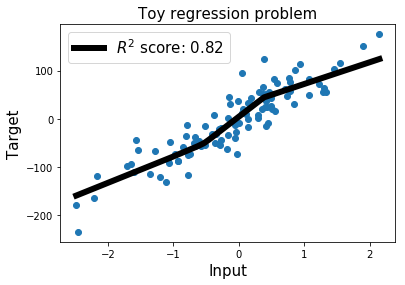
- TensorFlow 1.x 深度学习秘籍
- 零、前言
- 一、TensorFlow 简介
- 二、回归
- 三、神经网络:感知器
- 四、卷积神经网络
- 五、高级卷积神经网络
- 六、循环神经网络
- 七、无监督学习
- 八、自编码器
- 九、强化学习
- 十、移动计算
- 十一、生成模型和 CapsNet
- 十二、分布式 TensorFlow 和云深度学习
- 十三、AutoML 和学习如何学习(元学习)
- 十四、TensorFlow 处理单元
- 使用 TensorFlow 构建机器学习项目中文版
- 一、探索和转换数据
- 二、聚类
- 三、线性回归
- 四、逻辑回归
- 五、简单的前馈神经网络
- 六、卷积神经网络
- 七、循环神经网络和 LSTM
- 八、深度神经网络
- 九、大规模运行模型 -- GPU 和服务
- 十、库安装和其他提示
- TensorFlow 深度学习中文第二版
- 一、人工神经网络
- 二、TensorFlow v1.6 的新功能是什么?
- 三、实现前馈神经网络
- 四、CNN 实战
- 五、使用 TensorFlow 实现自编码器
- 六、RNN 和梯度消失或爆炸问题
- 七、TensorFlow GPU 配置
- 八、TFLearn
- 九、使用协同过滤的电影推荐
- 十、OpenAI Gym
- TensorFlow 深度学习实战指南中文版
- 一、入门
- 二、深度神经网络
- 三、卷积神经网络
- 四、循环神经网络介绍
- 五、总结
- 精通 TensorFlow 1.x
- 一、TensorFlow 101
- 二、TensorFlow 的高级库
- 三、Keras 101
- 四、TensorFlow 中的经典机器学习
- 五、TensorFlow 和 Keras 中的神经网络和 MLP
- 六、TensorFlow 和 Keras 中的 RNN
- 七、TensorFlow 和 Keras 中的用于时间序列数据的 RNN
- 八、TensorFlow 和 Keras 中的用于文本数据的 RNN
- 九、TensorFlow 和 Keras 中的 CNN
- 十、TensorFlow 和 Keras 中的自编码器
- 十一、TF 服务:生产中的 TensorFlow 模型
- 十二、迁移学习和预训练模型
- 十三、深度强化学习
- 十四、生成对抗网络
- 十五、TensorFlow 集群的分布式模型
- 十六、移动和嵌入式平台上的 TensorFlow 模型
- 十七、R 中的 TensorFlow 和 Keras
- 十八、调试 TensorFlow 模型
- 十九、张量处理单元
- TensorFlow 机器学习秘籍中文第二版
- 一、TensorFlow 入门
- 二、TensorFlow 的方式
- 三、线性回归
- 四、支持向量机
- 五、最近邻方法
- 六、神经网络
- 七、自然语言处理
- 八、卷积神经网络
- 九、循环神经网络
- 十、将 TensorFlow 投入生产
- 十一、更多 TensorFlow
- 与 TensorFlow 的初次接触
- 前言
- 1. TensorFlow 基础知识
- 2. TensorFlow 中的线性回归
- 3. TensorFlow 中的聚类
- 4. TensorFlow 中的单层神经网络
- 5. TensorFlow 中的多层神经网络
- 6. 并行
- 后记
- TensorFlow 学习指南
- 一、基础
- 二、线性模型
- 三、学习
- 四、分布式
- TensorFlow Rager 教程
- 一、如何使用 TensorFlow Eager 构建简单的神经网络
- 二、在 Eager 模式中使用指标
- 三、如何保存和恢复训练模型
- 四、文本序列到 TFRecords
- 五、如何将原始图片数据转换为 TFRecords
- 六、如何使用 TensorFlow Eager 从 TFRecords 批量读取数据
- 七、使用 TensorFlow Eager 构建用于情感识别的卷积神经网络(CNN)
- 八、用于 TensorFlow Eager 序列分类的动态循坏神经网络
- 九、用于 TensorFlow Eager 时间序列回归的递归神经网络
- TensorFlow 高效编程
- 图嵌入综述:问题,技术与应用
- 一、引言
- 三、图嵌入的问题设定
- 四、图嵌入技术
- 基于边重构的优化问题
- 应用
- 基于深度学习的推荐系统:综述和新视角
- 引言
- 基于深度学习的推荐:最先进的技术
- 基于卷积神经网络的推荐
- 关于卷积神经网络我们理解了什么
- 第1章概论
- 第2章多层网络
- 2.1.4生成对抗网络
- 2.2.1最近ConvNets演变中的关键架构
- 2.2.2走向ConvNet不变性
- 2.3时空卷积网络
- 第3章了解ConvNets构建块
- 3.2整改
- 3.3规范化
- 3.4汇集
- 第四章现状
- 4.2打开问题
- 参考
- 机器学习超级复习笔记
- Python 迁移学习实用指南
- 零、前言
- 一、机器学习基础
- 二、深度学习基础
- 三、了解深度学习架构
- 四、迁移学习基础
- 五、释放迁移学习的力量
- 六、图像识别与分类
- 七、文本文件分类
- 八、音频事件识别与分类
- 九、DeepDream
- 十、自动图像字幕生成器
- 十一、图像着色
- 面向计算机视觉的深度学习
- 零、前言
- 一、入门
- 二、图像分类
- 三、图像检索
- 四、对象检测
- 五、语义分割
- 六、相似性学习
- 七、图像字幕
- 八、生成模型
- 九、视频分类
- 十、部署
- 深度学习快速参考
- 零、前言
- 一、深度学习的基础
- 二、使用深度学习解决回归问题
- 三、使用 TensorBoard 监控网络训练
- 四、使用深度学习解决二分类问题
- 五、使用 Keras 解决多分类问题
- 六、超参数优化
- 七、从头开始训练 CNN
- 八、将预训练的 CNN 用于迁移学习
- 九、从头开始训练 RNN
- 十、使用词嵌入从头开始训练 LSTM
- 十一、训练 Seq2Seq 模型
- 十二、深度强化学习
- 十三、生成对抗网络
- TensorFlow 2.0 快速入门指南
- 零、前言
- 第 1 部分:TensorFlow 2.00 Alpha 简介
- 一、TensorFlow 2 简介
- 二、Keras:TensorFlow 2 的高级 API
- 三、TensorFlow 2 和 ANN 技术
- 第 2 部分:TensorFlow 2.00 Alpha 中的监督和无监督学习
- 四、TensorFlow 2 和监督机器学习
- 五、TensorFlow 2 和无监督学习
- 第 3 部分:TensorFlow 2.00 Alpha 的神经网络应用
- 六、使用 TensorFlow 2 识别图像
- 七、TensorFlow 2 和神经风格迁移
- 八、TensorFlow 2 和循环神经网络
- 九、TensorFlow 估计器和 TensorFlow HUB
- 十、从 tf1.12 转换为 tf2
- TensorFlow 入门
- 零、前言
- 一、TensorFlow 基本概念
- 二、TensorFlow 数学运算
- 三、机器学习入门
- 四、神经网络简介
- 五、深度学习
- 六、TensorFlow GPU 编程和服务
- TensorFlow 卷积神经网络实用指南
- 零、前言
- 一、TensorFlow 的设置和介绍
- 二、深度学习和卷积神经网络
- 三、TensorFlow 中的图像分类
- 四、目标检测与分割
- 五、VGG,Inception,ResNet 和 MobileNets
- 六、自编码器,变分自编码器和生成对抗网络
- 七、迁移学习
- 八、机器学习最佳实践和故障排除
- 九、大规模训练
- 十、参考文献
